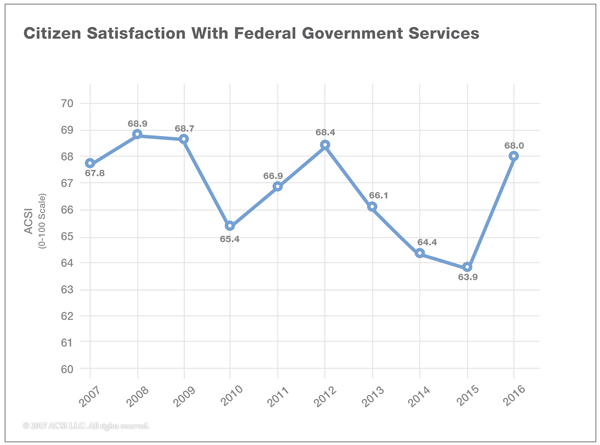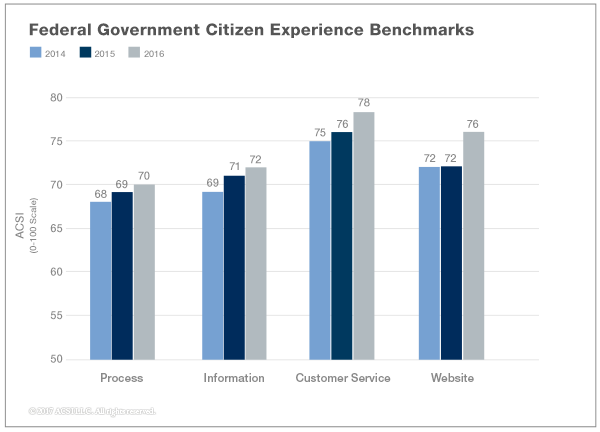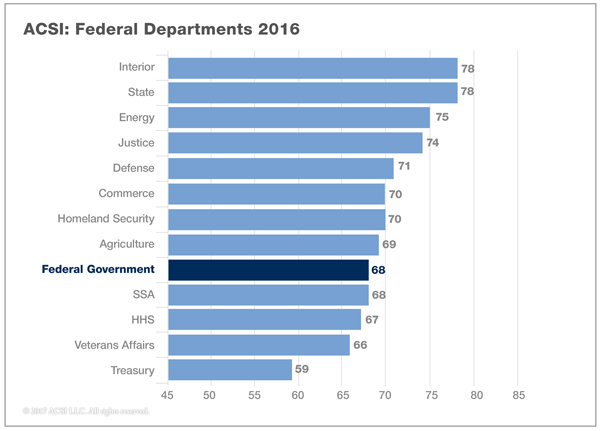State, Interior lead customer satisfaction survey while HHS surges thanks to HealthCare.gov
Citizen satisfaction with government services rebounded to a four-year high in 2016, driven largely by improved performances on the part of government websites.
Citizen satisfaction with government services rebounded to a four-year high in 2016, driven largely by improved performances on the part of government websites.
The 2016 American Customer Satisfaction Index measures citizen experience with federal agencies. Overall, satisfaction with government improved from 63.9 percent to 68 percent.

It looks at four different attributes — process, information, customer service and website — which all showed improvements, although websites increased most in 2016.

“Also, really interestingly for this week, the increase was really driven by satisfaction with [Health and Human Services] and particularly the HealthCare.gov website,” Mallory Barg Bulman, vice president for research and evaluation at the Partnership for Public Service, told the Federal Drive with Tom Temin. “So that’s really something for the new administration to think about as they talk about any changes to the Affordable Care Act. More citizens are using, and it sounds like they are using it with great satisfaction at this point.”
According to the report, HHS was once one of the least known agencies, having few public interactions. However, with the Affordable Care Act, almost 10 million Americans now interact with the agency through HealthCare.gov.
Meanwhile, the departments of State and Interior led the pack among individual departments. State’s interactions with customers primarily revolve around issuing passports and visas, while Interior’s public-facing segments mostly involve national parks, both government functions that tend to leave customers with higher levels of satisfaction.

Conversely, Treasury brings up the rear largely due to the Internal Revenue Service. The general unpleasantness of taxes is compounded by yearly, politically-motivated funding cuts that make it very difficult for the agency to complete its mission.
Bulman said she would like to see more emphasis on customer service in the agencies, matching that of the private sector.
“I would break it down to three primary things: The first that the PPS has said is that ‘Managers need to empower employees to do the right thing for customers.’ We’ve found time and time again that almost every federal employee really wants to do the right thing by citizens, and often, they bump up against rigid rules. They need to know that they’re going to be supported if they’re doing things to make the experience better for citizens. That’s a message and a tone that can come directly from the top,” Bulman said. “The second is helping employees get exposure to customers, whether through rotation with direct citizen-facing parts of the organization, or what we call ‘user personas,’ where they start to talk about which type of citizens use the service of the organization. And the third part I would say is measurement. We always say whatever gets measured gets done. When customer experience is built into performance expectations of employees at all levels, it’s more likely to be a focus of the organization.”
Copyright © 2025 Federal News Network. All rights reserved. This website is not intended for users located within the European Economic Area.
Daisy Thornton is Federal News Network’s digital managing editor. In addition to her editing responsibilities, she covers federal management, workforce and technology issues. She is also the commentary editor; email her your letters to the editor and pitches for contributed bylines.
Follow @dthorntonWFED





